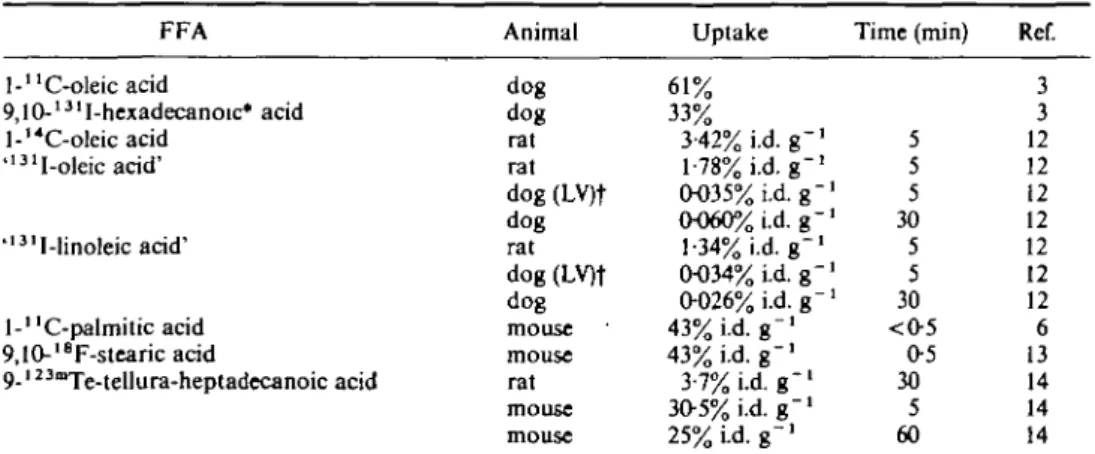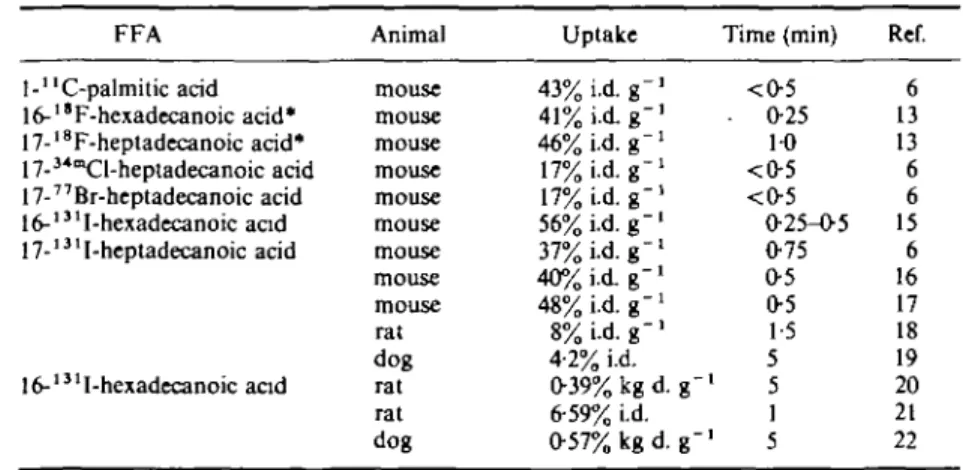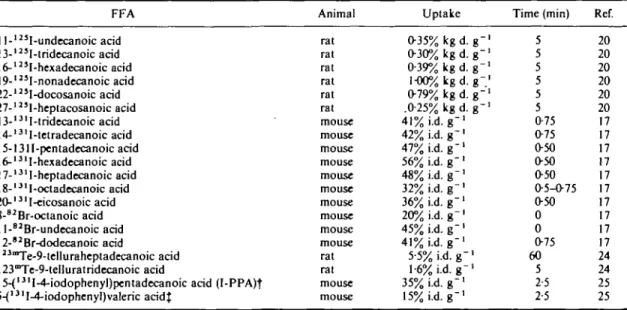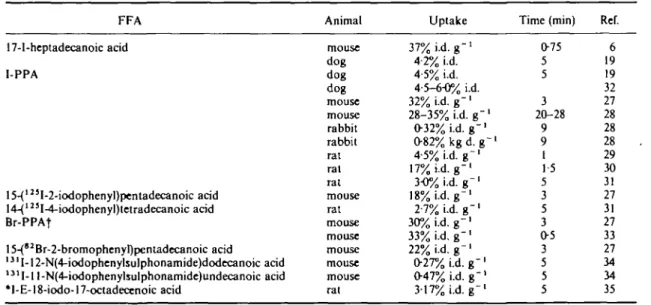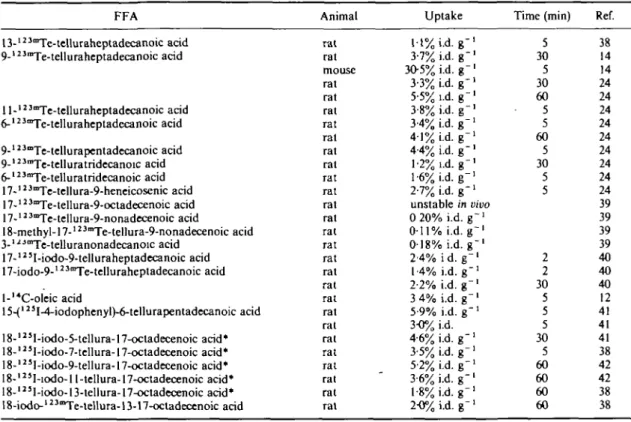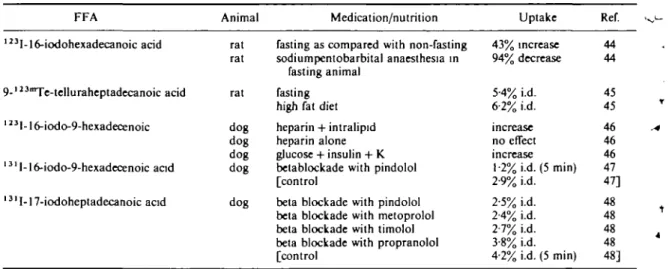Myocardial uptake of radioactively labelled
free fatty acids
G. WESTERA* AND F . C. VlSSERf
* Department of Nuclear Medicine, University Hospital, Rdmistrasse 100, 8091 Zurich, Switzerland and ^Department of Cardiology, Free University Hospital, De Boelelaan 1117, 1007 MB Amsterdam, The
Netherlands
KEY WORDS: Myocardial uptake, free fatty acids.
Structural variations in the carbon chain of free fatty acids influence the uptake of free fatty acids in the myocardium. To enable the use of free fatty acids in nuclear cardiology, various methods of introducing gamma-emitting isotopes have been evaluated.
The uptake of various free fatty acids is described and structure-activity relationships deduced.
Introduction
In the search for a tracer substance to monitor fatty acid metabolism in the heart by myocardial scintigraphy, several different free fatty acids ('unesterified fatty acid', FFAs) analogues have been described.
Three factors are of prime importance, when judging the value of any radiopharmaceutical:
(a) the uptake in the target organ (also in relation to the uptake in other tissues),
(b) the residence time/elimination rate of the compound in/from the target organ,
(c) the biochemical pathway by which the com-pound is metabolized in the body.
The last two aspects are dealt with by authors in other contributions to this supplement, and will only be mentioned here when it is pertinent to the 'uptake' process. Thus, only FFAs, which have been labelled with gamma-emitting radionuclides and for which pertinent uptake data are available will be discussed here.
'Normal' FFAs labelled with Carbon-11
"C-labelled fatty acids (which are chemically indistinguishable from naturally occurring FFAs) have been studied in nuclear cardiology mainly to demonstrate their use in positron-emission tomography. Attention has been focussed on the
dynamic behaviour of these compounds (their clearance from the heart) and mostly only qualitative measures of their uptake have been obtained"'2'.
Myocardial uptake has been measured as the extraction fraction in dogs and rabbits and as the percentage of the injected dose per gram of tissue (% i.d. g " ' ) in rats and mice (Table 1(3"9)).
The amount of data given in Table 1 hardly allow any conclusions, although there is general agreement with conclusions from other studies which will be discussed below.
Because of the need for a cyclotron to produce UC (which has a 20-min half life) and for a positron camera to detect this nuclide, a search for FFAs labelled with other nuclides has been in progress from the start. Focus has been on radiohalogenated and particularly radioiodinated compounds.
FFAs labelled along the carbon chain
The first attempt to visualize the heart using radiolabelled FFAs was with oleic acid, iodinated over the double bond( 1 0 t l l ). Thus a product is obtained labelled in the middle of the carbon chain and with the bulky iodine in this position, myocardial uptake was relatively low*3'12'. The introduction of the smaller fluorine-18 atom in the same position did not influence uptake (Table 2(13)). This indicates that for a substituent in the middle of the carbon chain its size determines the influence on myocardial uptake.
Table I Myocardial uptake of FFAs labelled with lxCorl*C FFA l-"C-stearic acid l-"C-oleic acid l-"C-palmitic acid 16-'*C-palmitic acid l-"C-octanoic acid l-"C-propanoic acid l-l4C-acetic acid Animal dog dog dog rabbit mouse rat rabbit mouse dog Uptake 70% 61% 52% 23% 43% Ld. g "1 2-6% i.d. g"> 56% 60% ' ' Time (min) <O5 5 10 Ref. 3 3 4 5 6 7 4 8 9 The following apply in the tables in this paper
% extraction fraction.
% i.d. percentage of injected dose in total organ. % i.d. g~' percentage of injected dose per gram of organ.
% kg d. g "1 percentage of injected dose per gram of organ divided by body weight in kg.
Time Time after injection of uptake given in min (unless otherwise stated). Where possible the maximum uptake with its time after injection will be given. Maximum uptake in mice and rats is in less than O5-1-0 min.
FFA Free (unestenfied) fatty acid.
The introduction of tellurium as a link in the
carbon chain can be compared to the presence of a
double bond
<14).
The effect of a (non-radioactive) methyl substituent
along the chain will be treated separately (Table 8).
Labelling in the 2-position
Another way to influence biological behaviour of
FFAs is to introduce a substituent on the carbon
atom neighbouring the acid function (that is next to
the COOH- group: the 2- or alpha-position).
Halogens have been introduced there, with
considerable reduction of myocardial uptake
(Table 3
(6>'
3)). An electrophilic substituent in the
2-position makes the organic acid stronger (i.e. more
apt to dissociate its H
+) and thus more hydrophilic
('water loving'). Especially fluorine and (to a lesser
extent) chlorine will exert their influence via such a
mechanism. This effect becomes less pronounced for
Table 2 Uptake in the heart of FFAs labelled in the middle of the carbon chain (for abbreviations see Table 1) FFA l-uC-oleic acid 9,10-13lI-hexadecanoic* acid l-'*C-oleic acid "3 1I-oleicacid' '13lI-linoleic acid' l-"C-palmitic acid 9,10-l8F-stearic acid 9-l23mTe-tellura-heptadecanoic acid Animal dog dog rat rat dog (LV)f dog rat dog (LV)f dog mouse mouse rat mouse mouse Uptake 61% 33% 3-42% i.d. g~' 1-78% i.d. g "1 0035% i.d. g~' 0060% i.d. g "1 1-34% i.d. g -1 0034% L d g -1 0-026% i.d. g~' 43% i.d. g "1 43% i.d. g "1 3-7% i.d. g "1 30-5% i.d. g "1 2 5 % L d . g - ' Time (min) 5 5 5 30 5 5 30 <0-5 0-5 30 5 60 Ref. 3 3 12 12 12 12 12 12 12 6 13 14 14 14 • Iodinated linoleic and linolenic acid gave results, indistinguishable from iodinated oleic acid'31. t LV: the uptake in the left ventricle (LV) is given. Right ventricular uptake was comparable. Atrial uptake tended to be less.
Table 3 Myocardial uptake of 2-substituted FFAs (for units see Table I) FFA l-"C-stearic acid 2-19F-stearic acid 2-3*mCl-stearic acid 2-77Br-stearic acid 2-l23I-stearic acid 2-13'I-hexadecanoic acid Animal mouse mouse mouse mouse mouse mouse Uptake 43% i.d. g" 11% Ld. g" 23% i.d. g" 15% i.d. g" 14% i.d. g-20% i.d. g" Time (min) < 0 5 0-5 1-5 0-5 1-5 < 1 Ref. 6 6 6 6 6 15
the larger halogens bromine and iodine, but then the steric effect becomes more important and the heart uptake of 2-iodo- and 2-bromo-FFAs was found to be rather low*6 1".
Labelling in the omega-position
Because the uptake of the 'iodinated oleic acid' was less satisfactory, it was proposed*3' to label FFAs at the end of the carbon chain, where it would affect the stereochemistry of the carbon chain to the least extent. And if the halogen-label was to be iodine, its size would match that of a methyl group and moreover little polarization of the terminal carbon-halogen bond (C-X-bond) would occur with accompanying little effect on the lipofilicity. It was thus found (Table 4< 6 1 5"2 2 )) that omega-iodinated compounds are taken up by the myocardium to about the same extent as 'normal' FFAs.
If the label is the more polarizing halogen bromine or chlorine, omega-labelled FFAs are taken up less(6); this effect has for F been offset by its small size: the uptake of a fluoro-compound equals that of an unlabelled FFA(13).
As a result of these findings, labelling of FFAs is now almost exclusively in the omega-position.
The influence of unsaturation
The presence of a double bond in the carbon chain does not seem notably to influence the uptake of an FFA in the heart (Table 50.1s.19.">) although the results of different groups are not very consistent. Thus our finding'19) that there is a significantly different uptake between the 17- and 18-carbon analogues (16-I-hexadecenoic acid and 17-1-heptadecanoic acid) is the consequence of the number of C-atorris rather than of the unsaturation in the 16-I-hexadecenoic acid.
Again (as with the saturated FFAs) bromo-instead of iodo-labelling reduces uptake con-siderably'15).
Contrary to the effect of a double bond, a triple bond( 1 5'1 7 > 2 2 ) reduces myocardial uptake con-siderably. This is a consequence of the more stringent stereochemical requirements imposed on the carbon chain by a triple compared with a double bond. Also the electronic configuration around a
Table 4 Uptake in the heart of omega-halogenaled straight chain saturated FFAs with 16-18 C-atoms (for units see Table I)
FFA l-"C-palmitic acid 16-"F-hexadecanoic acid* 17-18F-heptadecanoic acid* 17-34mCl-heptadecanoic acid 17-77Br-heptadecanoic acid 16-'31I-hexadecanoic acid 17-131I-heptadecanoic acid 16-'31I-hexadecanoic and Animal mouse mouse mouse mouse mouse mouse mouse mouse mouse rat dog rat rat dog Uptake 43% i.d. g" 41% i.d. g" 46% i.d. g~ 17% i.d. 17% i.d. g-56% Ld. g" 37% Ld. g -40% i.d. g" 48% i.d. g-8% i.d. g " ' 4-2% i.d. 0-39% kg d. g-6-59% i.d. 0-57% kg d. g-Time (min) <O5 • 025 1-0 <0-5 <0-5 0-25-0-5 0-75 0-5 0-5 1-5 5 5 1 1 5 Ref. 6 13 13 6 6 15 6 16 17 18 19 20 21 22
Table 5 Myocardial uptake of various unsaturated FFAi (for abbreviations see Table I) FFA 16-131I-hexadecanoic acid 16-131I-9-hexadecenoicacid E Z l6-82Br-9-hexadecenoic acid 16-l31I-9-hexadecenoic acid 14-l31I-7-tetradecynoic acid 15-l31I-9-pentadecynoic acid 16-131l-9-hexadecynoic acid 18-l31I-9-octadecynoic acid 20-'3' 1-12-eicosynoic acid 16-l31I-hexadecanoic acid 14-131-9-hexadecynoic acid Animal mouse mouse mouse mouse mouse dog dog mouse mouse mouse mouse mouse dog dog Uptake 56%i.d.g-' 55% id. g - ' 51% i.d. g -l 39%i.d. g - ' 27%i.d.g-' 77% 2-4% i.d. 19% i.d. g"1 30%i.d. g - ' 43% i.d. g - ' 32% i.d. g -1 39% i.d. g"1 0 5 7 % k g d . g - ' 0-49% kg d. g"1 Time (min) 0-25-0-5 0-5-0-75 0-5-0-75 0-0-25 0 5 5 025 0-O25 0-O25 0-O25 0-O25 5 5 Ret 15 15 15 15 23 3 19 17 17 17 17 17 22 22
triple bond is different, probably increasing the polarity of the molecule.
The influence of chain length—odd/even effect? The fatty acids which are mostly used by the body have 16 or 18 carbon atoms. As can be seen (Table 6(I7-20)) the myocardial uptake of these FFAs
is also highest. Obviously the uptake mechanism, which governs the transport of FFAs from the blood into the cells has a preference for these long-chain FFAs.
The higher uptake of FFAs for longer chains can also be seen with the unsaturated compounds (Table 5(17)) although the interpretation here is obscured by the influence of the triple bond. And the same has been observed for FFAs where Te is one of
Table 6 Uptake of FFAs in the heart with varying length of the C-chain—omega labelled, except '""Te (for abbreviations see Table I) FFA 1 l-123I-undecanoic acid 13-l23I-tridecanoic acid 16-125I-hexadecanoic acid 19-'23I-nonadecanoic acid 22-l25I-docosanoic acid 27-12'I-heptacosanoic acid 13-l3lI-tridecanoic acid 14-131I-tetradecanoic acid 15-1311-pentadecanoic acid 16-131I-hexadecanoic acid 17-131I-heptadecanoic acid 18-13lI-octadecanoic acid 20-l31I-eicosanoic acid 8-82Br-octanoic acid 1 l-"Br-undecanoic acid 12-82Br-dodecanoic acid 123mTe-9-telluraheptadecanoic acid 123Te-9-telluratridecanoic acid
15-{13lI-4-iodophenyl)pentadecanoic acid (I-PPA)t 5-{13lI-4-iodophenyl)valeric acidf Animal rat rat rat rat rat rat mouse mouse mouse mouse mouse mouse mouse mouse mouse mouse rat rat mouse mouse Uptake 035% kg d. g" 030% kg d. g-039% kg d. g" 1-O0%kgd.079% kg d. .025% kg d. g-41% i.d. g " ' 42% i.d. g - ' 47% i.d. g"1 56% i.d. g"1 48% i.d. g"1 32% i.d. g - ' 36%i.d.g"' 20% i.d. g"1 45% i.d. g " ' 41% i.d. g"1 5-5% i.d. g - ' 1-6% i.d. g -1 35%i.d.g-' 15% i.d. g - ' Time (min) 5 5 5 5 5 5 075 075 050 O50 050 05-O75 O50 0 0 075 60 5 2-5 2-5 Ref. 20 20 20 20 20 20 17 17 17 17 17 17 17 17 17 17 24 24 25 25 t 'I-PPA: 15-{*I-4-iodophenyl)pentadecanoic acid with *I for radioiodine.
the links in the carbon chain (Table 6(24)). Observa-tions with omega-bromo-substituted FFAs and omega-halophenyl-substituted compounds (Table 6(I7-25)) also confirm this point.
In nature, practically all FFAs occur with an even number of C-atoms. The beta-oxidation metabolism of FFAs breaks these compounds down by chopping off two C-atoms (an acetyl-group) at a time(26). If there is an odd number of C-atoms the last unit will have three C-atoms (propionyl group). In the catabolic behaviour a clear odd/even effect has been observed with 1 8F as the label'13'.
Although it is difficult to establish because of the large standard deviations in the results and because one can hardly compare the results of one group with those of another, one may tentatively read from the data presented that FFAs with an odd number of C-atoms in the chain are taken up by the heart to a lesser extent than even numbered ones. It must be borne in mind that the omega-iodine label in the case of FFA uptake can be treated as a methyl group. Therefore an omega-iodinated FFA must, for the sake of this argument, be considered as having a C-chain with one extra atom. The reasoning is further complicated by the fact, that the odd/even effect is necessarily accompanied by a change in the length of the C-chain. We have shown an odd/even effect more clearly in the dog*19).
Omega-phenyl substituted FFAs
Because myocardial elimination of FFAs is fairly fast (half life values in man ~ 10-20 min) resulting (with radiohalogenated FFAs) in high blood levels and thus in high background levels in scintigraphy, several structural alterations in the C-chain have been made to prolong myocardial residence time and to reduce (blood) background levels.
One approach has been to introduce a phenyl group in the omega-position and then label this aromatic ring with the radiohalogen. The radio-halogen will go to the ortho- (or 2-) or para- (or 4-) position. It was immediately established (in the case of omega-phenyl-pentadecanoic acid), that ortho substitution led to less uptake than para substitution (Table 7)(27). The para compound was taken up by the heart to about the same extent, as 'normal' omega-iodinated FFAs (Table 7(27"33)) although once again results from different papers are impossible to compare.
The uptake of the bromo-substituted phenylpenta-decanoic acid was the same as for the iodo-compound (Table 7<27)) indicating that the halogen label did not influence the polarity of the C-chain to an appreciable extent.
On the contrary, when the phenyl group was coupled to the C-chain via an electron-rich linkage
Table 7 Myocardial uptake of omega-phenyl- and omega-vinyl-FFAs (for abbreviations see Tables 1 and 6)
FFA Animal Uptake Time (min) Ref.
17-I-heptadecanoic acid I-PPA 15-{'23I-2-iodophenyl)pentadecanoic acid 14-(123I-4-i<xlophenyl)tetradecanoic acid Br-PPAf 15-(8JBr-2-bromophenyl)pentadecanoic acid 1 3' I-12-N(4-iodophenylsulphonamide)dodecanoic acid 131I-1 l-N(4-iodophenylsulphonamide)undecanoic acid *I-E-18-iodo-17-octadecenoic acid mouse dog dog dog mouse mouse rabbit rabbit rat rat rat mouse rat mouse mouse mouse mouse mouse rat 37% i.d. g"1 4-2% i.d. 4-5% i.d. 4-5-6-0% i.d. 32% i.d. g -1 28-35% i.d. g " ' 032% i.d. g"1 0 8 2 % k g d . g ~1 4-5% i.d. g"1 17% i.d. g"1 3-0% i.d. g"1 18% i.d. g"1 2-7% i.d. g"1 30% i.d. g - ' 33% i.d. g -1 22% i.d. g " ' 027% i.d. g - ' 047% i.d. g"1 317% i.d. g -1 075 5 5 3 20-28 9 9 1 1-5 5 3 5 3 0 5 3 5 5 5 6 19 19 32 27 28 28 28 29 30 31 27 31 27 33 27 34 34 35 t *Br-PPA: 15-(*Br-4-bromophenyl)pentadecanoic acid with *Br for radiobromine.
such as in p-iodophenyl-sulphonamide alkanoic acids (Table 7(34)) no myocardial uptake was observed.
3-methyl pentadecanoic acid shows relatively high uptake (Table 8(31)).
Omega-vinyl substituted FFAs
Another structural feature which (from the chemical point of view) belongs under the same heading (in stabilizing the iodine on the C-chain) as an omega-vinyl group, would be the omega-vinyl group, labelled with iodine trans with respect to the rest of the C-chain. This leads to uptake in the heart comparable to that of omega-phenyl substitution (Table 7(35)).
Methyl-branching of the carbon-chain
Another structural feature for prolonging myocardial residence time of FFAs could be the introduction of a methyl group in the carbon chain, because this would block beta oxidation.
This seems to work reasonably well for 14C and " C labelled FFAs (Table 8( 7 3 6 )), but far less so for omega-iodinated beta-methyl compounds'37'. In the former case uptake remains normal, whereas in the latter case the 5-min retention period is considerably less than for the corresponding straight chain compounds.
The combination of para-phenyl substitution and a beta methyl group also does not work particularly well: again heart uptake is relatively low (Table 8<37)). However, here the relative shortness of the C-chain may play an important role, because the corresponding longer chain
para-iodophenyl-Tellura fatty acids
Apart from the former mentioned changes in FFA-structure, in which the C-chain remained essentially intact, another approach for prolonging myocardial half lives of FFAs has been to insert a tellurium atom (Te) as a link in the C-chain. This also blocks the normal beta-oxidation mechanism (Table S*"4'24'38"42'). For high uptake values the usual C-chain length of 16 or 18 carbons was optimal.
Obviously the position of the Te in the C-chain is also of great influence on heart uptake: high uptake is only found if the Te is in the middle of the chain; positions too close to either end give essentially lower uptake.
Because of the unfavourable radiation charac-teristics of 123raTe (physical half life 120 days), the tellurium concept has been extended in that inactive Te is being inserted in the chain, whereas the chain is omega-labelled with radioiodine.
If the iodine is simply coupled to the carbon chain the iodine seems to be cut off directly'40' and thus the tellurium-radioiodine concept was extended once more to include stabilization of the radioiodine as the para iodophenyl-'41' or the trans iodovinyl-'38-421 group. This was shown to work reasonably well.
Again it turned out that the Te must be in the middle of the C-chain to get the higher uptake
Table 8 Uptake in the heart of methyl-substituted FFAs (for abbreviations see Tables I and 6)
FFA Animal Uptake Time (min) Ref.
16-14C-palmitic acid l-14C-3-methylheptadecanoic acid l-"C-3-methylheptadecanoic acid 16-'"I-hexadccanoic acid 13-1J5I-3-methyltridecanoic acid 16-123I-3-methylhexadecanoic acid 14-l25I-3,3'-dimethyltetradecanoic acid ' " I - P P A 8-0"I-4-iodophenyl)-3-methyloctanoic acid ' " I - P P A 15-{l2'I-4-iodophenyl)-3-methylpentadecanoic acid 14-(l23I-4-iodophenyI)tetradecanoic acid 14-025I-4-iodophenyl)-3-methyltetradecanoic acid rat rat rat rat dog rat rat rat rat rat rat rat rat rat rat 2-6% i.d. g - ' 4-3% i.d. g -1 2-9% i.d. g - ' 2-0% i.d. 8-3% i.d. 0-39% kg d. g- 0-13%kgd.0-34% kg d. g-0 g-0 3 % kg d. g 0-69% kg d. g 0 1 7 % k g d g -2-98% i.d. g "1 4-62% i.d. g "1 2 72% i.d. g -1 1-71% i.d. g "1 - 1 - 1 - i - I - 1 i 5 15 30 30 5 5 5 5 5 5 5 5 5 5 7 7 36 36 36 37 37 37 37 37 37 31 31 31 31
Table 9 Myocardial uptake of FFAs with tellurium as a link in the carbon chain, including omega-phenyl and omega-vinyl compounds (for abbreviations see Table 1)
FFA Animal Uptake Time (min) Ref.
V 13-i"Te.telluraheptadecanoic a cjd 9-'"Te-telluraheptadecanoic ^ j ll-'2 3Te-telluraheptadecanoic acid 6-l23mTe-telluraheptadecanoic acid 9-123"Te-tellurapentadecanoic acid 9-123mTe-telluratridecanoic acid 6-123mTe-telluratridecanoic acid 1 7 -n 3mTe-tellura-9-heneicosenic acid 17-123mTe-tellura-9-octadecenoic acid 17-1J3mTe-tellura-9-nonadecenoic acid 18-methyl-17-'"Te-tellura-9-nonadecenoic acid 3-ljMTe-telluranonadecanoic acid 17-'2 5I-iodo-9-telluraheptadecanoic acid 17-iodo-9-123aTe-telluraheptadecanoic acid l-l4C-oleic acid
15-(123I-4-iodophenyl)-6-tellurapentadecanoic acid 18-l25I-iodo-5-tellura-17-ocladecenoic acid* 18-123I-iodo-7-tellura-17-octadecenoic acid* 18-123I-iodo-9-tellura-17-octadecenoic acid* 18-l23I-iodo-l 1-tellura-l7-octadecenoic acid* 18-l23I-iodo-13-tellura-17-octadecenoic acid* 18-iodo-' 23°Te-tellura-13-17-octadecenoic acid
rat rat mouse rat rat rat rat rat rat rat rat rat rat rat rat rat rat rat rat rat rat rat rat rat rat rat rat rat 1 1 % i.d. g" 3-7% i.d. g-3O5% i.d. g" 3-3% i.d. g-5-5% i.d. g" 3 8 % i.d. g" 3-4% i.d. g" 4 1 % i.d. g" 4 4 % i.d. g" 12% i.d. g" 1-6% i.d. g" 2-7% i.d. g"1 unstable in vivo 0 20% i.d. g"1 0-11% i.d. g~' 0 1 8 % i.d. g"1 2-4% i d. g" 1-4% i.d. g" 2-2% i.d. g" 3 4% i.d. g" 5-9% i.d. g" 3-0% i.d. 4-6% i.d. g"1 3-5% i.d. g " ' 5-2% i.d. g"1 3-6% i.d. g"1 1-8% i.d. g"1 2-0% i.d. g-5 30 5 30 60 5 5 60 5 30 5 5 2 2 30 5 5 5 30 5 60 60 60 60 38 14 14 24 24 24 24 24 24 24 24 24 39 39 39 39 40 40 40 12 41 41 41 38 42 42 38 38 * The double bond in the 17-position is the vinyl group.
values. Interestingly, once Te was inserted in 18-iodo-tellura-l 7-octadecenoic acid in the 13-position, uptake was far less than for the 5-position(38>42): thus if the Te is close to the carboxyl group it has a less detrimental effect on uptake values.
Problems
It is difficult to reach any general conclusions from the present knowledge on FFA uptake because of the inconsistency of the results, either from a comparison of data from different groups or even from one and the same group. Also the use of different units to express the (relative) uptake values, without giving sufficient particulars to convert the data confuses the issue. Units used are % (extraction fraction), % of injected dose per total organ, % of injected dose per gram of tissue, % kg dose per gram of tissue (which
includes the body weight) (see the various tables in this review), ECAT units(2) and cpm g " ' ( U 4 3» .
Further confusion stems from the use of different experimental animals: mice, rats, rabbits, guinea pigs, dogs, calves and human beings have been studied. Particularly, the data on the small animals (mice, rats) are often reported from the fifth minute after injection, which means that no true maximum uptake values are given; the myocardial half life of FFAs in mice and rats is less than 1 min. Longer retained activity is associated mainly with the lipid fractions in the cell.
As FFAs are very important metabolic substrates for energy production, nutrition and medication can obviously be expected to influence FFA metabolism. Nevertheless the impact on myocardial uptake has hardly been studied (Table ltf44"48*).
It has been postulated that fasted rats showed higher heart uptake of I23I-16-iodohexadecanoic acid than non-fasted animals'441. Sodium
pento-Table 10 Influence FFA
of medication and nutrition on Animal
myocardiat uptake of FFAs (for abbreviations Medication/nutrition see Table Uptake 1) Ref. 123I-16-iodohexadecanoic acid 9-123Te-telluraheptadecanoic acid 1 "I-16-iodo-9-hexadecenoic 131l-16-iodo-9-hexadecenoic acid 1 3' I-17-iodoheptadecanoic acid rat rat rat dog dog dog dog dog
fasting as compared with non-fasting sodiumpentobarbital anaesthesia in
fasting animal fasting
high fat diet heparin + intralipid heparin alone glucose + insulin + K betablockade with pindolol [control
beta blockade with pindolol beta blockade with metoprolol beta blockade with timolol beta blockade with propranolol [control 43% increase 94% decrease 5-4% i.d. 6-2% i.d. increase no effect increase 1-2% i.d. (5 min) 2-9% i.d. 2-5% i.d. 2-4% i.d. 2-7% i.d. 3-8% i.d. 4-2% i.d. (5 min) 44 44 45 45 46 46 46 47 47] 48 48 48 48 48]
barbital anaesthesia decreased tracer uptake
especially in non-fasted animals. The fasting effect
was not found with
123™Te-9-tellura-heptadecanoic
acid
(45).
Treatment with heparin plus intralipid or with
glucose plus insulin plus potassium increased
myocardial accumulation of
123I-16-iodo-9-hexadecenoic acid in the heart of the dog. Heparin
along had no effect'
46*.
The beta blocker pindolol decreased uptake of this
tracer'
471. Treatment with beta blockers also reduced
the uptake of 17-iodoheptadecanoic acid
(48).
Thus data on the influence of nutrition and
medication are notably scanty and as yet allow for
no conclusions to be drawn.
Conclusions
Although a great many problems remain to be
solved, some general conclusions can be drawn:
Myocardial uptake is highest for the long-chain
FFAs with a carbon chain of 16 or 18 C-atoms.
Differences in uptake as a consequence of the
number of C-atoms being odd or even (odd
numbered FFAs are taken up to a lesser extent)
require further study.
Branching of the chain by introduction of a
methylgroup or the bigger halogens reduces
myocardial uptake. The small fluorine atom only has
an effect on uptake in the 2-position (beside the
carboxyl group) because of its influence on the acid
strength.
Substitution at the end of the C-chain reduces
uptake only when it results in higher polarity of the
molecule.
A double bond in the carbon chain [either in the
middle or at the end (omega-vinyl-)] does not
appreciably influence uptake in the heart, whereas a
triple bond causes appreciable reduction.
The replacement of one of the C-atoms of the
chain by a tellurium atom reduces uptake, once the
Te is too close to either end of the molecule; a Te in
the middle leaves uptake essentially unaffected.
Myocardial uptake of FFAs has been considered
to proceed by passive diffusion. However, this would
not account for all observed selectivities, the
structure-activity relationships described above. It
seems more likely that two mechanisms operate: (a)
passive diffusion, favouring the more lipofilic,
long-chain FFA, which is reduced once the molecule is
made more polar by substitution and (b) a carrier
mediated mechanism, which favours FFAs with an
appropriate length of 16 or 18 C-atoms.
An impressive number of various FFAs have now
been synthesized and used in various biological
experiments. In our opinion there is at present no
need for more variations on this theme, but the
available compounds must be used to do the
appropriate biological research. In this respect the
search for better uptake characteristics seems of less
importance than understanding the dynamic
behaviour of the favoured compound; higher uptake
can hardly be expected, considering the
above-mentioned structure-activity relationships, whereas
the importance of (very) long retention times is a question of interpretation. Unless a compound can be found which depicts reversibly ischaemic areas in the heart at rest (without exercise), FFAs do not present an improvement with regard to 2O1 T1-thallium for the localization of ischaemia. But possibly a fair understanding of dynamic FFA behaviour under normal and pathological conditions may turn radiolabelled FFAs into a useful diagnostic tool.
In further biological research, more unity in the execution of the experiments and the presentation of the data would be advantageous. We have argued<48) that the uptake in % of injected dose per total heart is more relevant than, e.g. the more used % of injected dose per gram of organ, but whatever ones opinion on this, all relevant data should be given, to enable the results in one favoured set of units to be converted to another.
References
(1) Lerch RA, Bergmann SR, Ambos HD, Welch MJ, Ter-Pogossian MM, Sobel BE. Effect of flow-independent reduction of metabolism on regional myocardial clearance of C-l 1-palmitate. Circulation
1982; 65: 731-8.
(2) Schelbert HR. Stoffwechsel des Herzens: Neue Unter-suchungsmoeglichkeiten durch Positronen-Computer-Tomographie. Der Nuklearmediziner 1983; 6: 3-23. (3) Poe ND, Robinson G D Jr, MacDonald NS.
Myocardial extraction of labeled long-chain fatty acid analogs. Proc Soc Exp Biol Med 1975; 148: 215-8. (4) Schelbert HR, Henze E, Schoen HR et al. C-l 1
palmitate for the noninvasive evaluation of regional myocardial fatty acid metabolism with positron computed tomography. III. In vivo demonstration of the effects of substrate availability on myoc metabolism. Am Heart J 1983; 105: 492-504. (5) Weiss ES, Hoffman EJ, Phelps ME ei al. External
detection and visualization of myocardial ischemia with C-l I-substrates in vitro and in vivo. Circ Res
1976; 39: 24-32.
(6) Machulla HJ, Stoecklin G, Kupfernagel C et al. Comparative evaluation of fatty acids labeled with Cl-11, C-34m, Br-77 and I-123 for metabolic studies of the myocardium: concise communication. J Nucl Med 1978; 19: 298-302.
(7) Elmaleh DR, Livni E, Shlomo L, Varnum D, Strauss HW, Brownell GL. Comparison of C-l 1 and C-14 labeled fatty acids and their beta-methyl analogs. Int J Nucl Med Biol 1983;I(h 181-7.
(8) Ji Q, Wang Y, Zhang J et al. In vivo distribution and organ imaging of C11benzoic acid and C l l -propionic acid in animals. Nucl Tech 1983; 6: 65-6. (9) Selwyn AP, MacArthur C, Allan R, Pike V, Jones T.
Myocardial ischemia; metabolic studies using positron tomography. Eighth Eur Congr Cardiol Paris, 1980: 194 (Abstr).
(10) Evans JR, Gunton RW et al. Use of radioiodinated
fatty acid for photoscans of the heart. Circ Res 1965; 16: 1-10.
( l l ) B o n t e FJ, Graham KD, Moore JG. Experimental myocardial imaging with I-131-labeled oleic acid. Radiology 1973; 108: 195-6.
(12) Beierwaltes WH, Ice RD, Shaw MJ, Ryo UY. Myocardial uptake of labeled oleic and linoleic acids. J Nucl Med 1975; 16: 842-5.
(13) Knust EJ, Kupfernagel C, Stoecklin G. Long-chain F-18 fatty acids for the study of regional metabolism in heart and liver; odd-even effects of metabolism in mice. J Nucl Med 1979; 20: 1170-5.
(14) Elmaleh DR, Knapp F F Jr, Yasuda T et al. Myocardial imaging with 9-[Te-123m]tellurahepta-decanoic acid. J Nucl Med 1981; 22: 994-9.
(15) Riche F, Mathieu JP, Busquet G et al. Etude biologique d'acides gras en C-l6 marques par un atome radioactif. J Biophys Med Nucl 1983; 7: 87-95. (16) Angelberger P, Wagner-Loeffler M, Dudczak R, Hruby R. I-123(131)-labeled aliphatic and aromatic fatty acids: optimized preparation and biodistribution. Radioakt Isot Klin Forsch 1982; 15: 249-64. (17) Riche F, Mathieu JP, Comet M et al. Influence de la
longueur de la chaine et du nombre pair ou impair d'atoms de carbone sur le comportement biologique des acides gras iodes. J Biophys Med Nucl 1983; 7: 97-106.
(18) Reske SN, Auner G, Winkler C. Kinetics of 17-(I-I23) iodoheptadecanoic acid in myocardium of rats. J Radioanal Chem 1983; 79: 355-61.
(19) Westera G, Van der Wall EE, Visser FC, Den Hollander W, Heidendal GAK, Roos JP. The uptake of iodinated free fatty acids in the (ischemic) dog heart. Indications for a dual uptake mechanism. Int J Nucl Med Biol 1983; 10: 231-6.
(20) Otto CA, Brown LE, Wieland DM, Beierwaltes WH. Radioiodinated fatty acids for myocardial imaging: Effects of chain length. J. Nucl Med 1981; 22: 613-8. (21)Okada RD, Elmaleh D, Werre GS, Strauss HW.
Myocardial kinetics of I-123-labelled-16-hexadecanoic acid. Eur J Nucl Med 1983; 8: 211-7.
(22) Otto CA, Brown LE, Wieland DM, Beierwaltes WH. Synthesis of 125-l-labeled 14-iodo- 9-tetradecynoic acid. J Labeled Comp Radiopharm XVIII: 1981;
1347-55.
(23) Sun QX, Zhang J, Ji QM et al. Pharmacology of radioiodinated hexadecenoic acid. A myocardial imaging agent. Nucl Med 1984; 23: 73-4.
(24) Knapp FF Jr, Ambrose KR, Callahan AP, Ferren LA, Gribsby RA, Irgolic KJ. Effects of chain length and tellurium position on the myocardial uptake of Te-123m fatty acids. J Nucl Med 1981; 22: 988-93. (25) Machulla HJ, Dutschka K, Marsmann M, Van
Beuningen D. Radiopharmaceuticals III. Synthesis and myocardial uptake of 5-p-123-I-phenyl valeric acid. Radiochem Radioanal Lett 1981; 46: 317-22. (26) Martin DW, Mayes PA, Rodwell VW (eds). Harper's
biochemistry. Lange Medical Publications, 18th ed. 1981.
(27) Machulla HJ, Marsmann M , . Dutschka K, Van Beuningen D. Radiopharmaceuticals II. Radio-bromination of phenylpentadecanoic acid and biodistribution in mice. Radiochem Radioanal Lett 1980; 42: 243-50.
(28) Angelberger P, Wagner-Loffler M, Dudczak R el al. 123-1 and 131-1 labeled p-Iodophenyl pentadecanoic acid: simplified preparation, biodistribution in mice, rabbits and patients. In: Cox PH, ed. Progress in radiopharmacology, vol. 2. Elsevier/North Holland Biomedical Press, 1981: 61-74.
(29) Ercan M, Senekowitsch R, Bauer R, Reidel G, Kriegel H, Pabst HW. In vivo and in vitro studies with omega-[p-I-123-phenyl]-pentadecanoic acid in rats. Int J Appl Radiat Isot 1983; 34: 1519-24.
(30) Reske SN. Jod-123-Phenyl-Pentadecansaeure: Ein neuer Tracer zur Untersuchung des myokardialen Metabolismus freier Fettsaeuren. Der Nuklear-mediziner 1983; 6: 25-46.
(31) Goodman MM, Kirsch G, Knapp FF Jr. Synthesis and evaluation of radioiodinated terminal p-iodo-phenyl-substituted alpha- and beta-methyl branched fatty acids. J Med Chem 1984; 27: 390-7.
(32) Reske SN, Schoen S, Knust EJ el al. Relation of myocardial blood flow and initial cardiac uptake of 15-(p-I-123-phenyl)- pentadecanoic acid in the canine heart. Nucl Med 1984; 23: 83-5.
(33) Coenen HH, Harmand MF, Kloster G, Stoecklin G. 15-(p-[Br-75]bromophenyl)-pentadecanoic acid: Phar-macokinetics and potential as heart agent. J Nucl Med 1981; 22: 891-6.
(34) Fritzberg AR, Eshima D. Iodophenyl-sulfonamide fatty acid analogs as potential myocardial imaging agents. Int J Appl Radiat Isot 1982; 33: 451-53. (35) Knapp FF Jr, Goodman MM, Kabalka GW, Sastry
KAR. Synthesis and evaluation of radioiodinated (E)-18-17-octadecenoic acid as a model iodo-alkenyl fatty acid for myocardial imaging. J Med Chem 1984; 27: 94-7.
(36) Livni E, Elmaleh DR, Levy S, Brownell GL, Strauss WH. Beta-methyl[l-C-ll]heptadecanoic acid: A new myocardial metabolic tracer for positron emission tomography. J Nucl Med 1982; 23: 169-75.
(37) Otto CA, Brown LE, Scott AM. Radioiodinated branched-chain fatty acids: Substrates for beta oxidation? Concise communication. J Nucl Med 1984; 25: 75-80.
(38) Knapp FF Jr, Goodman MM, Callahan AP, Ferren LA, Kabalka GW, Sastry KAR. New myocardial
imaging agents: stabilization of radioiodine as a terminal vinyl iodide moiety on tellurium fatty acids. J Med Chem 1983; 26: 1293-300.
(39) Basmadjian GP, Mills SL, Ice RD. Synthesis, biological distribution and radiation dosimetry of tellurium-123m analogs of hexadecenoic acid. Nucl Med Commun 1982; 3: 150-4.
(40) Goodman MM, Knapp FF, Callahan AP, Ferren LA. Synthesis and biological evaluation of 17-(131-I)iodo-9-tellura- heptadecanoic acid, a potential myocardial imaging agent. J Med Chem 1982; 25: 613-8. (41) Goodman MM, Knapp FF Jr, Callahan AP, Ferren
LA. A new, well-retained myocardial imaging agent: radioiodinated 15-(p-Iodophenyl)-6-tellura-penta-decanoic acid. J Nucl Med 1982; 23: 904-8.
(42) Knapp FF Jr, Srivastava PC, Callahan AP, Cunningham EB, Kabalka GW, Sastry KAR. Effect of tellurium position on the myocardial uptake of radioiodinated 18-iodotellura- 17-octadecenoic acid analogues. J Med Chem 1984; 27: 57-63.
(43) Chien- KR, Han A, White J, Kulkarni P. In vivo esterification of a synthetic 1-125 labeled fatty acid into cardiac glycerolipids. Am J Physiol 1983; 245: 693-7. (44) Brown LE, Mangner TJ, Marsh DD, Otto CA,
Wieland DM, Beierwaltes WH. Effects of nutritive state and anesthesia on heart uptake of fatty acid. J
Nucl Med 1981; 21: P 73.
(45) Elmaleh DR, Knapp FF, Yasuda T, Kopiwoda S, McKusick KA, Strauss HW. 123m-Te-9-tellura-heptadecanoic acid as myocardial imaging agent. J Nucl Med 1980; 21: P58.
(46) Comet M, Pilichowski P, Wolf JE el at. Myocardial scintigraphy with i.v. injections of 16-{I-123]iodo-9-hexadecenoic acid. Effect of plasma concentrations of fatty acids and glucose. J Biophys Med Nucl 1983; 7: 151-7.
(47) Van der Wall EE, Westera G, Den Hollander W, Visser FC, Roos JP, Heidendal GAK. The effect of pindolol on myocardial uptake of free fatty acids in the dog. Curr Ther Res 1983; 33: 591-600.
(48) Westera G, Van der Wall EE, Eenige van MJ el al. Metabolic consequences of beta-adrenergic receptor blockade for the acutely ischemic dog myocardium. Nuklearmedizin 1984; 23: 35-40.
